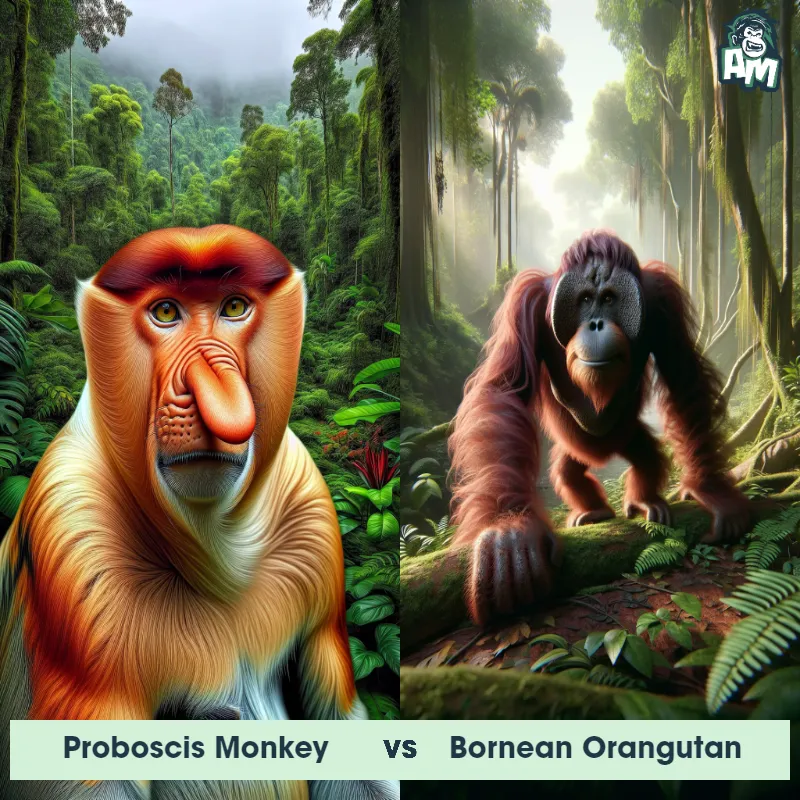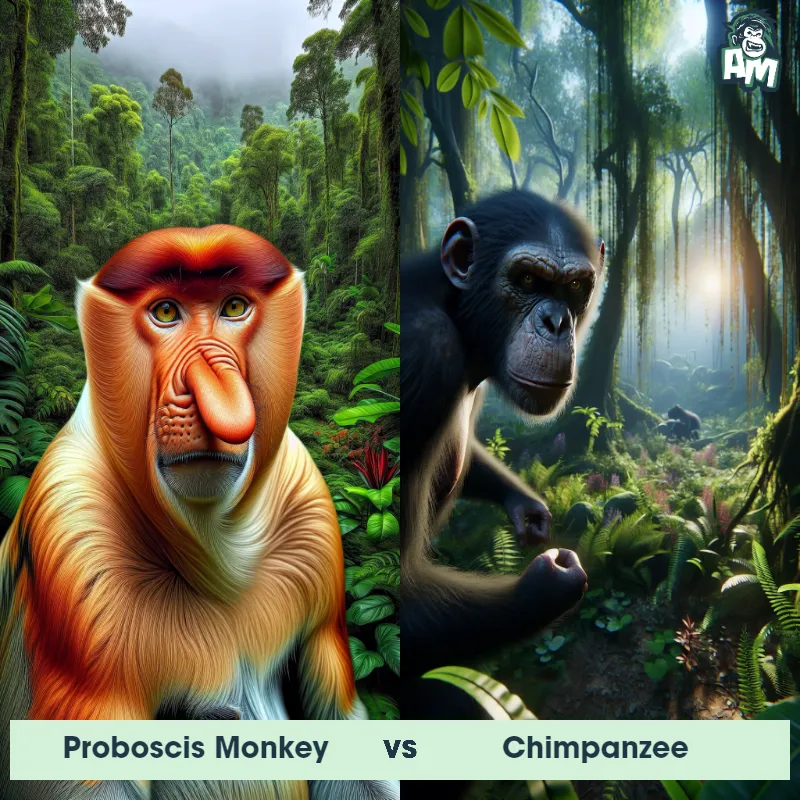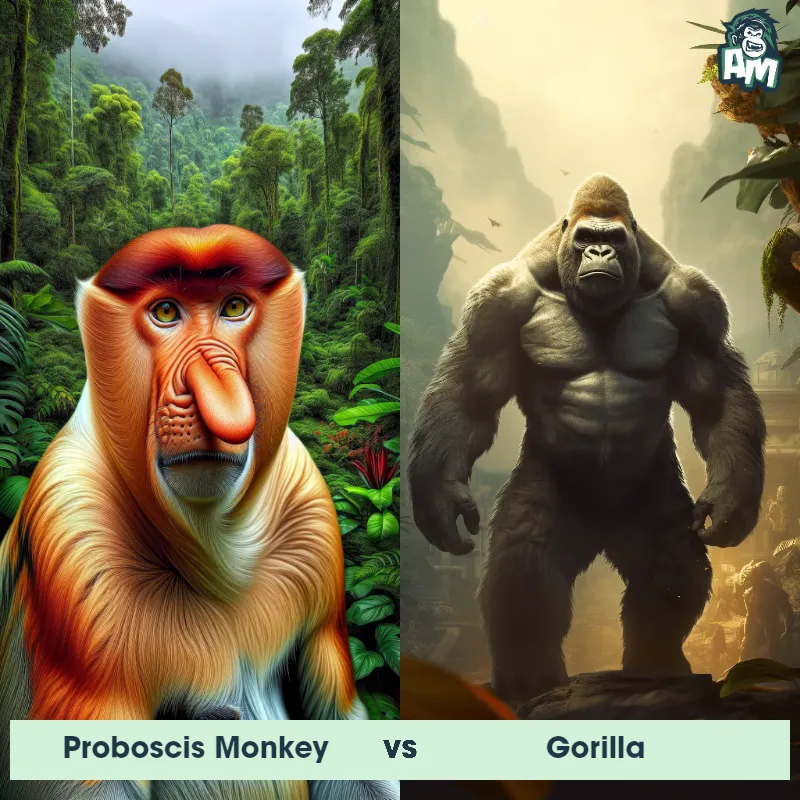The Proboscis Monkey
The Proboscis Monkey, also known as the long-nosed monkey or Nasalis larvatus, is native to the forests of Borneo. This unique primate is easily recognizable by its large, pendulous nose, which can grow up to 7 inches long in males. With a reddish-brown fur and a potbelly, they have long limbs and a tail that acts as a balancing tool when leaping between trees. Proboscis Monkeys primarily feed on leaves, fruits, and seeds, and they can be found in social groups known as harems, consisting of a dominant male, several females, and their offspring.

| Proboscis Monkey | |
|---|---|
| Size | Up to 2 feet (0.6 meters) tall |
| Weight | Up to 50 pounds (22.7 kilograms) |
| Speed | 20mph (32km/h) |
| Key Strength | Strong jaws and sharp teeth |
| Biggest Weakness | Relatively slow and not as agile as some other primates |
| Scientific Name | Nasalis larvatus |
| Family | Cercopithecidae |
| Habitat | Forests, mangroves, and riversides |
| Geography | Borneo |
| Diet | Leaves, fruits, seeds |
| Lifespan | 10 years - 20 years |

The Proboscis Monkey
The Proboscis Monkey, also known as the long-nosed monkey or Nasalis larvatus, is native to the forests of Borneo. This unique primate is easily recognizable by its large, pendulous nose, which can grow up to 7 inches long in males. With a reddish-brown fur and a potbelly, they have long limbs and a tail that acts as a balancing tool when leaping between trees. Proboscis Monkeys primarily feed on leaves, fruits, and seeds, and they can be found in social groups known as harems, consisting of a dominant male, several females, and their offspring.
Fun Fact: The long nose of the Proboscis Monkey serves a purpose beyond its peculiar appearance - it amplifies the monkey's honking calls, allowing them to be heard over long distances in the dense forest.
| Proboscis Monkey | |
|---|---|
| Size | Up to 2 feet (0.6 meters) tall |
| Weight | Up to 50 pounds (22.7 kilograms) |
| Speed | 20mph (32km/h) |
| Key Strength | Strong jaws and sharp teeth |
| Biggest Weakness | Relatively slow and not as agile as some other primates |
| Scientific Name | Nasalis larvatus |
| Family | Cercopithecidae |
| Habitat | Forests, mangroves, and riversides |
| Geography | Borneo |
| Diet | Leaves, fruits, seeds |
| Lifespan | 10 years - 20 years |
Proboscis Monkey Matchups
We use AI to simulate matchups between the Proboscis Monkey and other animals. Our simulation considers size, strength, and natural predatory behaviors to determine the most likely outcome.
Proboscis Monkey: Diet, Predators, Aggression, and Defensive Behaviors
What do Proboscis Monkeys eat?
Proboscis Monkeys are primarily herbivores, with their diet consisting mainly of leaves, fruits, and seeds. They have been known to occasionally consume insects as well.
Do Proboscis Monkeys have any predators?
Proboscis Monkeys face threats from a few predators in their natural habitat, including crocodiles, large birds of prey, and pythons. Additionally, humans are also a significant threat to their survival due to habitat destruction and hunting.
Are Proboscis Monkeys aggressive?
Proboscis Monkeys are generally not aggressive towards humans or other animals unless provoked. They are known to exhibit territorial behavior towards other groups of monkeys, but physical aggression is relatively rare.
Do Proboscis Monkeys fight?
Proboscis Monkeys do engage in fights within their own group or with rival groups over territory or mating rights. These fights typically involve aggressive displays, such as loud vocalizations, chasing, and physical confrontations.
How do Proboscis Monkeys defend themselves?
Proboscis Monkeys have several methods of defending themselves against predators or threats, including agility in trees to escape predators, loud alarm calls to alert others of danger, and group defense by banding together to confront threats.
What is the biggest weakness of Proboscis Monkeys in a fight?
One of the biggest weaknesses of Proboscis Monkeys in a fight is their relatively slow ground movement compared to some predators or rival monkeys. Their large noses, while distinctive and sometimes used in displays, can also be a hindrance in physical confrontations.
Fun Fact: Proboscis Monkeys are excellent swimmers and are known for their ability to swim across rivers and bodies of water. They use their webbed feet as paddles to navigate through the water, making them one of the few primates that are capable swimmers.
Fun Fact: While most primates display a relatively uniform social structure, the Proboscis Monkeys have a unique social system where multiple harems may share a common territory, allowing for interactions between different groups and increasing opportunities for mating and socialization.















